Right of way rules and laws: Where is SUP prohibited? Who has right of way?
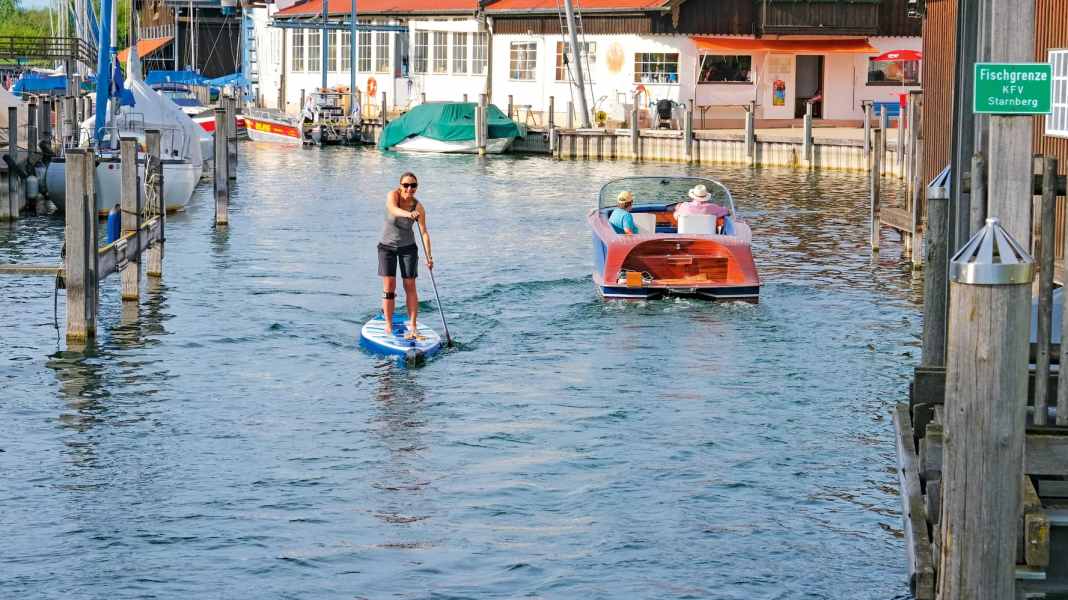
- Rules at sea
- Right of way rules between watercraft
- Rivers and lakes: Generally permitted, but there are local bans
- Where is SUP prohibited?
- Local SUP bans: Hamburg harbour area and Spree
- Special topic SEA and nature conservation
- Labelling requirement for SUP boards
- Rhine, Elbe and Co.: SUP on federal waterways
- Summary: Where is SUP prohibited, where is SUP permitted
- "Conservation zones and reed beds have the greatest potential for conflict" - Interview with Chief Superintendent Kai Motschmann
If you want to get out on the water on a SUP in Germany, you don't need a licence. That's great! However, you do get to travel further on a SUP than on an air mattress and therefore potentially into prohibited areas and have more contact with other water sports enthusiasts. A SUP course can therefore be useful for beginners with no water sports experience, because in addition to the efficient paddling technique - especially spot-specific - the local regulations are also discussed.
The increasing number of paddlers is not only a source of joy for other water sports enthusiasts. You can even understand this to some extent.
A driving licence for SUP is not required
Associations such as the VDWS (Association of German Water Sports Schools) or the GSUPA (German Stand Up Paddling Association) offer association-internal SUP licences or basic licences, which are intended to demonstrate knowledge in theory and practice after successfully completing courses. However, these licences are not compulsory on any body of water. There are no official licences
Rules at sea
Here the matter is simple and clear: anyone may use the German coastal waters free of charge for bathing, water and ice sports and enter the beach for this purpose. However, local restrictions (e.g. nature reserves) and access bans must be observed when entering the beach. Paddling on the sea is permitted. Shipping lanes marked by navigation marks (fairway buoys) may only be crossed by the shortest route; commercial shipping always has priority.
Right of way rules between watercraft
The four most important rules are actually easy to understand and cover almost every situation.
- Sailing power before muscle power: SUP must avoid all sailors
- Muscle power before engine power: small vehicles under engine give way to SUP
- Commercial shipping (including water rescue and fishermen) ALWAYS has priority
- Manoeuvre of the last moment: According to collision prevention rules, you must take evasive action at the last moment before a collision, even if you have the right of way. This is particularly sensible with a small SUP, even in your own interest.
Rivers and lakes: Generally permitted, but there are local bans
For rivers and lakes, the news is also initially positive: use is possible - where not prohibited - within the scope of so-called public use. In other words, the right granted to everyone under state law to use public property such as roads, paths or surface waters free of charge without special authorisation in accordance with their intended purpose. Typical forms of public use also predominantly include travelling on waters with small vehicles without their own propulsion - which includes stand-up paddling.
Keyword public use in legal gobbledygook
In Bavaria, for example, this public use is hidden in this tapeworm sentence in Article 18 of the Bavarian Water Act (BayWG): "Any person may, under the conditions of § 25 WHG and insofar as it can be done without unlawful use of other people's land and insofar as no significant impairment of the water body and its banks or of the flora and fauna is to be expected, use above-ground waters outside reed beds and reed beds for bathing, washing, watering, flushing, scooping with hand vessels, operating model boats without combustion engines, ice sports and travelling with small vehicles without their own propulsion."
A good indication that SUP boards are permitted on lakes and rivers is the presence of shipping traffic on the water in question. Where there is commercial shipping, excursion boats, motorboats, sailing boats, electric hire boats or pedal boats, paddling should also be possible in principle.
And if you are well informed, you can refute misinformation about SUP bans that is spread locally - such as on the Bavarian Würm: At the outflow from Lake Starnberg, the Würm flows through the Rambeck shipyard and harbour facility. One or two paddlers have probably been told that paddling along the course of the river through the facility is not permitted. This is incorrect information, as the public use of public waters applies here. Mooring at the dockyard or navigating the actual harbour, on the other hand, is not permitted.
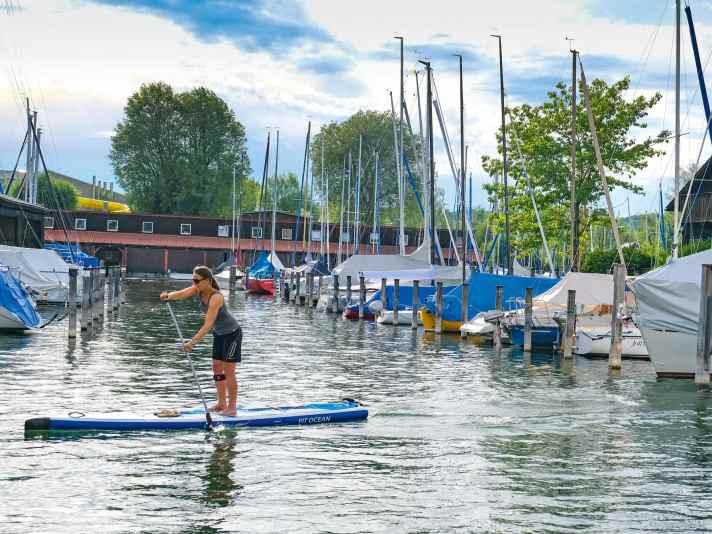
Where is SUP prohibited?
To say it straight away: we cannot say for every single body of water whether paddling is permitted there or not. However, we would like to use basic tips and practical examples to show you which prohibitions and navigation rules may apply - and where you can find information about them.
The public use of rivers and lakes described above is restricted where bodies of water are located in courtyards, gardens and parks or where they are drainable ponds used exclusively for fish farming. Stand-up paddling is taboo there. The same applies to many reservoirs, retention and storage basins. Exceptions prove the rule there too, of course.
Use may also be restricted if the water is privately owned. In Austria, for example, Lake Walchsee near Kufstein is a private lake on which paddling is only permitted for a day use fee - although a few years ago this was only displayed on a small ticket office or in a regulation that was difficult to find. Not exactly tourist-friendly.
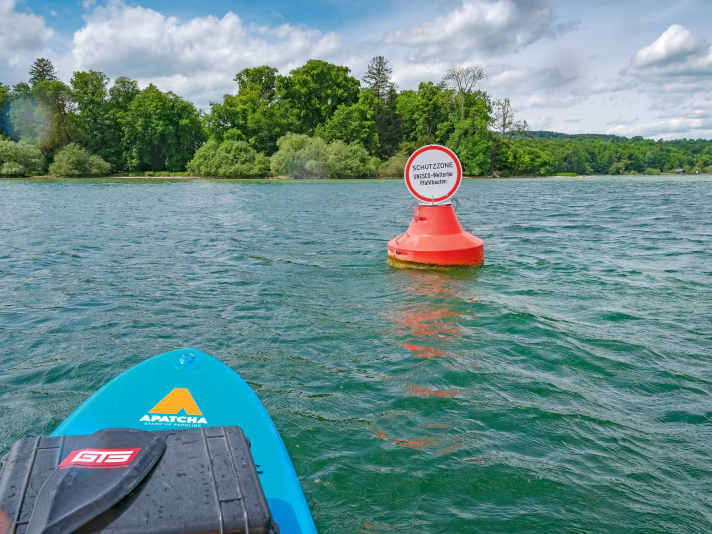
"Ticket booth" on the water
If you go out on the water without paying, you may be visited by the lake owner in an electric boat with a parasol - and asked to pay on the spot. In the middle of the water. What sounds like a hidden camera has turned out to be a true story, even for experienced paddlers. On the Bavarian Eibsee below the Zugspitze, which is also privately owned, paddling with your own boards is permitted free of charge. These two examples alone show how regional and difficult the matter is.
SUP prohibited on the Pegnitz
Some bodies of water are permanently subject to navigation bans. In Bavaria, for example, the Pegnitz in the Nuremberg region is closed to SUPs according to district regulations, whereas kayaks, canoes and Canadian canoes are permitted. And this is despite the fact that stand-up paddling is a canoeing discipline according to the German Canoeing Association. Well, who knows about the authorities and regulations!
Local SUP bans: Hamburg harbour area and Spree
In northern Germany, paddling in Hamburg harbour has been prohibited since 2019. This means that not only the harbour itself, but also Hamburg's beautiful Speicherstadt warehouse district and Hafen City are off-limits to stand-up paddlers. But with the Alster and the Alster canals, there are still plenty of great SUP spots in Hamburg. Or even the beautiful Dove-Elbe-Tourwhich we have described here as a tour. In Berlin, the Spree in the city centre between Oberbaumbrücke and Kanzleramtssteg is also closed to stand-up paddlers all year round - even though there are numerous sights to see here.
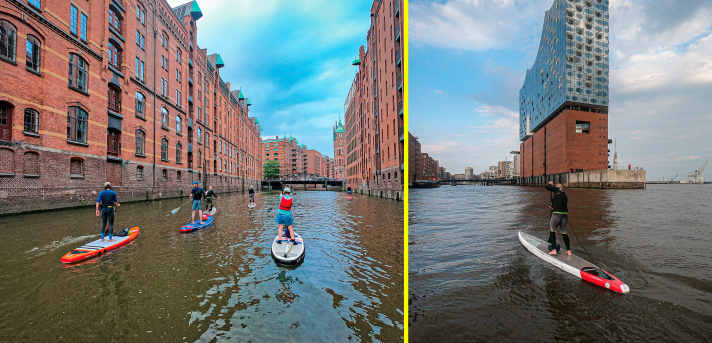
Nature conservation areas - such as the shallow water and island zone bird sanctuary in the Altmühlsee - are also often permanently closed. Such areas are usually marked with buoys that warn against entering.
Special topic SEA and nature conservation
In addition to permanent bans, there are also local, time-limited bans. These serve to protect breeding and spawning grounds, for example. Waters are closed for this purpose mainly from January to July, such as the Upper Bavarian rivers Amper and Würm.
You can also draw the attention of other paddlers to nature reserves and reed zones. Then it will also work with the conservationists.
Lakes Starnberg and Ammersee are also important resting and wintering areas for migratory birds. For this reason, year-round and seasonal resting areas have been designated here. There From 1 November to 30 March each year, there is also a voluntary ban on paddling and sailing. Paddlers there work closely with environmental and bird protection organisations, making a valuable contribution to environmental protection and nature conservation. The birds get the rest they need, can save energy and recharge their batteries. The times at which bodies of water may be paddled can also be regulated. On the Isar in the district of Bad-Tölz Wolfratshausen, for example, only between 7.00 am and 8.30 pm.
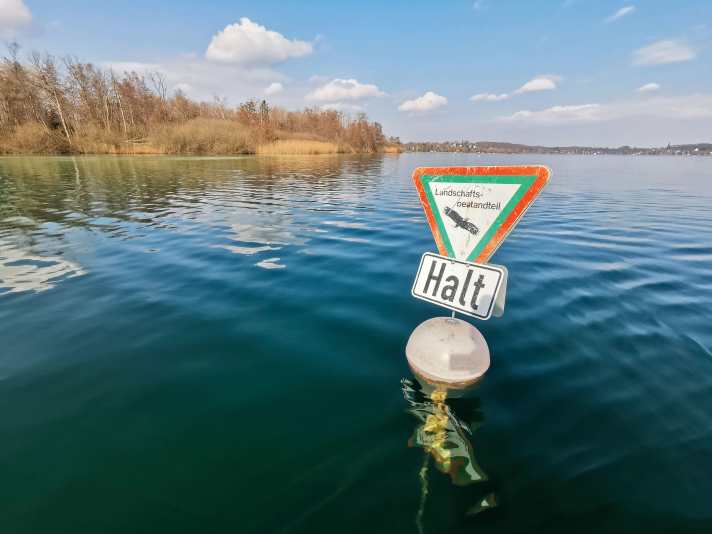
Commercial shipping and its jetties are off limits
You should always stay away from commercial shipping. This also includes commercial fishermen and, of course, excursion boats. This is good for everyone involved.
Paddlers may also be subject to minimum distances from passenger boat moorings, which must be adhered to in order to ensure safe mooring, casting off and manoeuvring. The entry and exit points on rivers and lakes can also be specified by the authorities - as the example of Wörthsee near Munich shows. In 2019, the local council there passed a bylaw stipulating that SUP boards may only be launched at two locations in the municipality of Wörthsee - even if there are more good spots.
Isar special zone
The controversial regulation issued by the district of Bad-Tölz Wolfratshausen in 2019 on navigating the Isar is probably unique in Germany, as it sets out requirements for the material used. All air-filled boats must be "suitable for white water". The regulation fails to provide a concrete definition of whitewater suitability, possibly in the case of SUPs through the shape, particularly stiff rails or additional handholds. It is probably a matter of interpretation as to what is a SUP suitable for white water and what is not.
Labelling requirement for SUP boards
On Lake Constance, for example, it is mandatory for boards to be labelled with the owner's name and address. In an emergency, rescue services can make contact quickly and clarify the situation - for example, if the board is found abandoned on the shore. Life jackets are also compulsory on Lake Constance if paddling further than 300 metres from the shore.
Paddling on rivers: Pay attention to the water level!
If you want to set off on a river tour, low water levels can put a spanner in the works. Paddling when the water level is too low can be harmful to nature and should therefore be avoided. There is a traffic light system for the Altmühl that shows whether the water level is below the average low water level and whether you should switch to another section or even a river. And on the Sieg, paddling is not permitted if the water level is below 30 centimetres at the Eitorf gauge.
Rhine, Elbe and Co.: SUP on federal waterways
Anyone travelling on federal waterways such as the Rhine (great 2-day tour here), which Elbe or the Main must comply with additional rules. The basic rule here is: keep well away from commercial shipping! You should also keep a close eye on upstream and downstream shipping traffic. Downstream vessels in particular are often late to hear and faster - and are therefore less noticeable. If the fairway is marked with red and green buoys, you should sail outside the fairway if possible - if the water level allows - or directly alongside the buoys. The buoys do not mark the permitted navigation area, only the navigation channel. This means that SUPs are permitted to paddle outside the fairway. The use of locks has been prohibited for stand-up paddlers in Germany since 2018. This means: Dismount and tow.
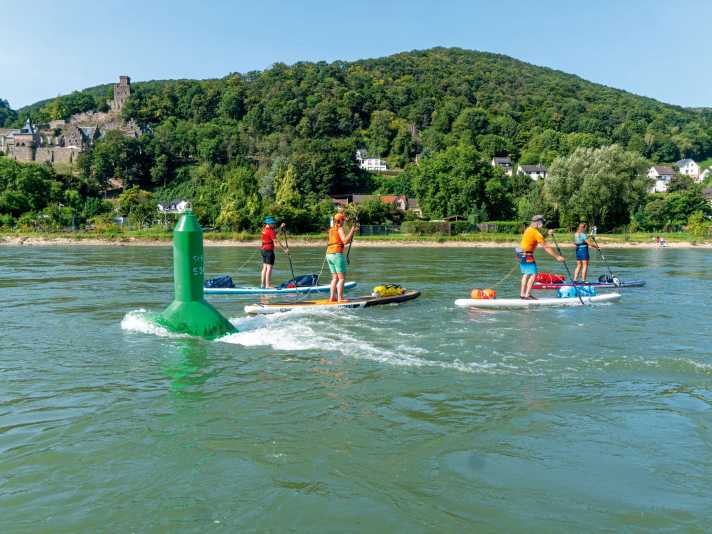
You can find most SUP navigation rules here
Unfortunately, there is no centralised source of information. A tried and tested source of information is the German Canoe Associationwho has been working for years with the navigation rules or the CANUA App provides reliable sources of information. It provides a clear and up-to-date list of navigation bans and navigation notices for rivers and lakes. For federal waterways, the "Electronic Federal Waterways Information System (ELWIS)" is the first port of call for up-to-date information.
This becomes trickier with local ordinances from municipalities, cities and districts. These can usually only be found on the websites with a lot of searching. Here you have to proceed like private detective Sherlock Holmes and search for clues using a combination of keywords (name of the body of water you are looking for + ordinance / bylaws / SUP ban). Here, as everywhere else, the general principle applies: ignorance is no defence against punishment. If you can't find anything on the internet, you can ask at local SUP shops or SUP centres that are familiar with the area and can provide information.
Other good sources of information are water sports hiking maps, the DKV water guides, books with tour descriptions as well as water and tour reports in magazines and on websites - both for SUP and canoeing. For canoeing, there are significantly more sources of information that paddlers can use for orientation. Forums and Facebook groups can also be helpful. In tourist areas that are well-developed for water sports, tourism associations are a good place to go - such as on the Main, Altmühl or Franconian Saale: they have extensive brochures on canoeing with all entry and exit points, maps and tips on accommodation, refreshment options and sights. And for river tours, we recommend visiting the website Flood control centres as a bookmark or install apps such as RiverApp or My Levels to check current water levels.
Summary: Where is SUP prohibited, where is SUP permitted
Permission:
- Coastal waters: can be used without restriction
- Rivers and lakes: usable by public use, where not prohibited or restricted
Restrictions and SUP bans:
- Privately owned waters
- Year-round/permanent traffic bans
- Time-limited travel bans (times, days, months)
- Nature conservation areas or areas of water worthy of protection
- Voluntary waivers
- Specifications for labelling, material, life jackets, entry and exit points
- On some bodies of water when the water level is too low (water level height)
Sources of information
Navigation rules:
- CANUA App
- DKV / German Canoe Association
- ELWIS (Electronic Waterways Information System of the Federal Government)
Websites / apps with water level information:
- Flood control centres
- River App
- The "My levels" app at Google or with Apple
- Ordinances of cities, municipalities, districts
Books / maps / magazines (SUP + canoe):
- Water sports hiking maps
- DKV Water Guide
- Books with tour descriptions
- Water and tour reports in magazines
"Conservation zones and reed beds have the greatest potential for conflict" - Interview with Chief Superintendent Kai Motschmann
What is the task of the waterway police?
Chief Superintendent Kai MotschmannThe water police have the task of monitoring compliance with legal regulations on waterways, in our case on Lake Starnberg in particular. Conflicts or infringements of the law by SUPs mainly occur in fine weather, when the number of SUPs becomes so large that other water sports enthusiasts can only carry out their activities to a limited extent, such as during sailing regattas, for example. The water police also make sure that restricted areas, such as spawning sanctuaries or nature reserves, are not used to protect the animals that live there. Here too, offences committed by SUPs are on the increase.
Otherwise, stand-up paddlers are unlikely to exceed the speed limit.
Here, too, the increasing number of stand-up paddlers should be viewed critically. Speed is certainly not the problem here. As already mentioned in the previous question, one of the greatest potential conflicts is travelling through protected areas and reedbeds, followed by obstructions from other watercraft (including passenger boats) and bathers.
What experience do you have with SUPers when you draw their attention to misbehaviour? Do you tend to meet with understanding or what are the usual reactions?
Ignorance is often feigned, even though the no-entry zones are clearly marked with buoys. However, these areas are then left with understanding when requested.
What are the penalties/fines for various offences?
Unlike on the road, there is no standard catalogue of fines for such offences. Each individual case is subject to a case-by-case assessment. The waterway police will record and document the facts on site and establish the personal details of the person responsible. As a rule, the offender will then be questioned again in writing about the offence committed. This administrative offence is then forwarded to the prosecuting authority, in this case the Starnberg District Office (LRA). From there, a warning or a fine notice is issued and sent to the person concerned.
Many stand-up paddlers are not experienced water sports enthusiasts. What are the most important rules you would like to teach them to avoid problems on the water?
- Correctly assess the weather conditions.
- Protection of nature, such as observing restricted areas and absolute avoidance of reed zones. Both on Lake Starnberg and on the Würm and other bodies of water.
- Sufficient distance to passenger ships, their jetties and routes.
- Distance to sailing regattas
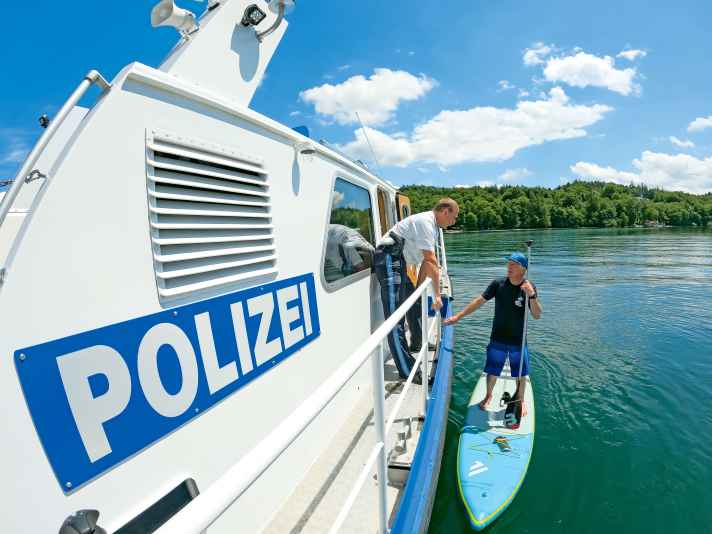
Which areas on the lake and on inland waterways in general are always off-limits for paddlers?
As already mentioned, travelling on the nature reserves and reed zones is prohibited all year round. The same applies to the bird sanctuary at St. Heinrich, which is located in the immediate vicinity of a SUP site with a school. It goes without saying that harbour areas or the area where passenger boats moor are not to be used if this could obstruct them.
Are there conflicts - in significant numbers - between stand-up paddlers and other water sports enthusiasts?
No specific cases are currently known, but there is a general increase in complaints from lake users about the increasing number of stand-up paddlers and the associated restrictions on other water sports enthusiasts. Such comments come from a wide range of sources, from sailors and professional fishermen to the captains of passenger boats.
According to my information, SUPs are something like "small vehicles under muscle power", is that generally true?
That is correct. This means that the use of the boards falls under public use and does not require authorisation. However, the situation is different if the SUPs are used commercially, such as in schools or on guided tours. Such activities are subject to authorisation and the operators of such activities must contact the Starnberg LRA and the Bavarian Castles and Lakes Administration before engaging in such activities.
How should SUPers behave in the vicinity of commercial shipping? How can you avoid stressful situations for everyone involved?
You should always inform yourself in advance about the moorings and the routes of the passenger ships to avoid such stressful situations in the first place. Anchoring and mooring is generally prohibited within a radius of 100 metres of moorings. Furthermore, SUPers must always give way to passenger ships. Due to the size of these ships and the fact that the steamer jetties are visible and well known, it should be possible to clear the shipping routes to the jetties easily and in good time.
How is the passage on the Würm through the harbour regulated for paddlers?
The Würm in the area of the Rambeck shipyard may be navigated in principle. However, mutual consideration is also the top priority here and the avoidance of obstructions is also prescribed in the Bavarian shipping regulations. However, it is not permitted to moor at the petrol station, the harbour facilities or the berths, for example.
What right of way rules apply to SUPers with regard to sailing boats and leisure motorboats?
All motorised boats must give way to rowing boats and therefore also SUPs. However, this does not apply to passenger boats or professional fishermen. This also means that SUPs must give way to sailing vessels, for example.
Have you ever experienced a special mission in connection with SUP?
I remember an experience when we were travelling on Lake Starnberg at night and navigating under radar. On the way back to Starnberg, in complete darkness, I suddenly recognised an object on the radar screen in front of our boat. We immediately stopped our service boat so that we could identify the object more precisely. As it turned out, it was a SUPer paddling across the lake in the dark, completely unlit. It was only thanks to the fact that our boat is equipped with radar that an accident could be avoided. Another sports boat without this equipment would hardly have been able to avoid a collision.
What are the most common incidents on the lake?
The most frequent incidents are administrative offences due to violations of the Bavarian shipping regulations. For example, non-compliance with the minimum distance from the shore, unauthorised sailing with doldrums with sailboats - without an emergency situation, operating motorboats without a licence or permit and sailing in restricted areas. In the latter case, the proportion of SUPs has risen significantly in recent years.

